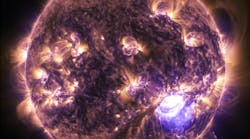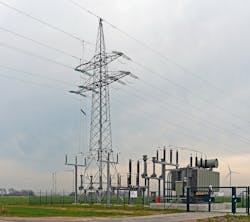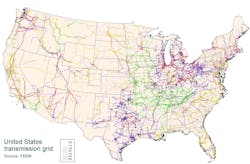Solar Storms and Their Potential to Create Electronic Chaos
What you’ll learn:
- History of solar events and their disruptive effects.
- How X-class flares can wreak havoc on satellites.
- The impact on the power grid and possible remedies.
Hollywood would have us believe that we could avert a global catastrophe from a solar flare by using technology (solar attack) or even harnessing the energy of CMEs (coronal mass ejections) through the manipulation of the earth's magnetic field (Cat. 8). No matter the movie, its improbable fictional technology would save us from doom in the event a massive solar flare strikes the earth. But it begs the question: Could humanity survive such an event?
Solar flares are intense eruptions of electromagnetic radiation in the sun's atmosphere, which are often followed by CMEs and solar particle events (proton acceleration). They also produce an immense amount of energy, usually 1020 joules, with significant activity pushing that number up to 1025 joules. Their frequency also varies during the sun's 11-year solar cycle, producing several per day during its maximum, to less than once a week during its minimum.
Such flares are classified by alphabetical letters and numerical suffixes, which range from A (weakest) to X (strongest), along with a magnitude peak flux in watts per square meter (W/m2). For example, an X2 flare is twice the strength of an X1 flare; an X3 flare is three times as powerful as an X1, but only 50% more powerful than an X2.
Solar winds carry those charged particles through the solar system, and when they hit the Earth, they produce those fantastic aurora light shows as it transfers its energy into the magnetosphere. While those light shows are an incredible display, those CMEs can also wreak havoc on space-based platforms and Earth-based systems. These pose a minor physical threat for those of us on the ground, but astronauts could be exposed to lethal amounts of radiation. High-energy particles could cause chromosome damage as they pass through living cells, leading to cancer and other health problems.
From Satellite Disruption to Power-Grid Failure
They also can damage navigation, communication, and other satellites, rendering them inoperable and even altering their orbits. Most satellites in low Earth orbit (LEO) require a routine boost into higher orbits to maintain flight; otherwise, they will burn up in the atmosphere. Skylab's 1979 destruction was partly due to higher-than-expected solar activity, resulting in the craft reentering the earth's atmosphere prematurely.
Satellite disruption can impact us here on earth in the form of communications and navigational loss, affecting flights and GPS systems that people rely on daily. Though such problems can be categorized as more of an inconvenience, they can be mitigated quickly by transferring workloads to other satellites that haven't been affected. On the other hand, electrical-grid disruption could be catastrophic and last for weeks or months.
The most powerful solar flare ever observed happened in September of 1859 and was known as the Carrington Event. It was visible to the naked eye, produced auroras as far south as Cuba and the Hawaiian Islands, and set telegraph wires on fire, knocking out communications. The flare left a trace in Greenland ice in the form of nitrates and beryllium-10, allowing scientists to measure its strength.
The reconstruction of the effects of the 1859 flare was compared with others documented over the last 150 years and was estimated to be around X50, the highest ever reported. In comparison, the largest measured in modern times occurred in November of 2003 and was estimated to be around X45, but it was not on a path that came in contact with the Earth.
In 1972, an X20-class solar flare produced a geomagnetic and proton storm that disrupted electrical and communication networks, destroyed a satellite, and detonated numerous U.S. Navy magnetic sea mines in North Vietnam waters. Again in 1989, a geomagnetic storm caused the collapse of Quebec's hydroelectric dam as equipment-protection relays tripped in a cascading sequence, which left 9 million people without power. Most of these storms, except for the Carrington Event, were localized, meaning they only affected a single geographic location. But could it leave an entire nation in darkness?
Identifying Grid Concerns
We rely on the power grid for everything—to power our homes, commute, recharge our mobile devices, and stock our grocery stores with fresh food. Hospitals rely on it for critical care, airports for navigation, and oil refineries to provide fuel. Without the grid, society would descend into chaos. Massive solar flares like the one in 1859 will happen again—it’s just a matter of time. But don't head for those doomsday bunkers just yet.
A 2020 study from the U.S. Geological Survey (USGS) shows that critical regions in the Midwest and eastern seaboard of the United States are more vulnerable to geomagnetic activity than others. While those regions are home to millions of people, a few preventative measures, such as stockpiling transformers and other electrical equipment, could help keep their lights on and groceries in their refrigerators.
According to the study, geology can help mitigate the effects of a magnetic storm on high-voltage power lines. Rocks, such as sedimentary formations, are relatively electrically conductive, meaning they're more effective at dissipating storm-induced electric fields. This means regions with these sedimentary rocks are more resilient to such storms. Fortunately, that's most of the U.S.
Some regions in the Midwest and East Coast lack the necessary sedimentary rock to dissipate magnetic fields, resulting in an increase of vulnerability to the effects and geomagnetic disturbances from solar flares. According to the report, a worst-case scenario would find those areas without power for weeks until replacement transformers could be produced and delivered.
It's important to note that in 2015, eight U.S. electric utilities created a transformer stockpile that can be accessed for emergency use, including geomagnetic storms and terrorist attacks. In March of 2019, President Trump instructed agencies to shore up the grid to protect against electromagnetic pulses to strengthen the grid further.
In that same month, the NOAA (National Oceanic and Atmospheric Agency) released a National Space Weather Strategy and Action Plan that supports three main objectives: enhancing critical infrastructure and assets, improving accuracy and timing of space weather forecasts, and establishing procedures for responding to and recovering from space weather events.
It's widely known among scientists that another sizeable solar flare will impact electrical grids around the globe. The good news is that most power utilities and government agencies have been preparing for another Carrington Event, identifying their respective grid vulnerabilities and working to keep them secure and functioning.
Want to see what us engineers might do during a catastrophic post-solar event? The movie Finch starring Tom Hanks paints a somewhat realistic picture of such a scenario. I would say, you can get the gist of the story in the first quarter or so. Critically speaking, the focus of the film after was somewhat repulsive and annoying. Ultimately leaving this viewer depressed at the story’s end and my newly acquired amount of wasted time. An accurate score, at two decimal places, of 2.31 out of 5.00.



